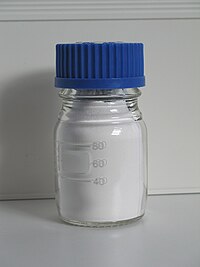Potassium perchlorate
 |
|||
|
|
|||
 |
|||
| Names | |||
|---|---|---|---|
| Other names
Potassium chlorate(VII); Perchloric acid, potassium salt; peroidin
|
|||
| Identifiers | |||
|
3D model (Jmol)
|
|||
| ChemSpider | |||
| ECHA InfoCard | 100.029.011 | ||
| EC Number | 231-912-9 | ||
|
PubChem CID
|
|||
| RTECS number | SC9700000 | ||
| UNII | |||
| UN number | 1489 | ||
|
|||
|
|||
| Properties | |||
| KClO4 | |||
| Molar mass | 138.55 g/mol | ||
| Appearance | colourless/ white crystalline powder | ||
| Density | 2.5239 g/cm3 | ||
| Melting point | 610 °C (1,130 °F; 883 K) decomposes from 400 °C |
||
| 0.76 g/100 mL (0 °C) 1.5 g/100 mL (25 °C) 4.76 g/100 mL (40 °C) 21.08 g/100 mL (100 °C) |
|||
|
Solubility product (Ksp)
|
1.05·10−2 | ||
| Solubility | negligible in alcohol insoluble in ether |
||
| Solubility in ethanol | 47 mg/kg (0 °C) 120 mg/kg (25 °C) |
||
| Solubility in acetone | 1.6 g/kg | ||
| Solubility in ethyl acetate | 15 mg/kg | ||
|
Refractive index (nD)
|
1.4724 | ||
| Structure | |||
| Rhombohedral | |||
| Thermochemistry | |||
| 111.35 J/mol·K | |||
|
Std molar
entropy (S |
150.86 J/mol·K | ||
|
Std enthalpy of
formation (ΔfH |
-433 kJ/mol | ||
|
Gibbs free energy (ΔfG˚)
|
-300.4 kJ/mol | ||
| Hazards | |||
| Safety data sheet | MSDS | ||
| GHS pictograms |
 
|
||
| GHS signal word | Danger | ||
| H271, H302 | |||
| P220 | |||
|
EU classification (DSD)
|
|
||
| R-phrases | R9, R22 | ||
| S-phrases | (S2), S13, S22, S27 | ||
| NFPA 704 | |||
| Related compounds | |||
|
Other anions
|
Potassium chloride Potassium chlorate Potassium periodate |
||
|
Other cations
|
Ammonium perchlorate Sodium perchlorate |
||
|
Except where otherwise noted, data are given for materials in their standard state (at 25 °C [77 °F], 100 kPa).
|
|||
|
|
|||
| Infobox references | |||
Potassium perchlorate is the inorganic salt with the chemical formula KClO4. Like other perchlorates, this salt is a strong oxidizer although it usually reacts very slowly with organic substances. This usually obtained as a colorless, crystalline solid is a common oxidizer used in fireworks, ammunition percussion caps, explosive primers, and is used variously in propellants, flash compositions, stars, and sparklers. It has been used as a solid rocket propellant, although in that application it has mostly been replaced by the higher performance ammonium perchlorate. KClO4 has the lowest solubility of the alkali metal perchlorates (1.5 g in 100 mL of water at 25 °C).
KClO4 is prepared industrially by treating an aqueous solution of sodium perchlorate with KCl. This single precipitation reaction exploits the low solubility of KClO4, which is about 100 times less than the solubility of NaClO4 (209.6 g/100 mL at 25 °C). It can also be produced by the reaction of perchloric acid with potassium hydroxide; however, this is not used widely due to the dangers of perchloric acid. In laboratory or by hobbists it can be prepared by bubbling chlorine gas through a solution of KClO3 and KOH. Another way to make it is the electrolysis of potassium chlorate solution,KClO4 form a precipitate at the anode.
KClO4 is an oxidizer in the sense that it exothermically transfers oxygen to combustible materials, greatly increasing their rate of combustion relative to that in air. Thus, with glucose it gives carbon dioxide:
...
Wikipedia



